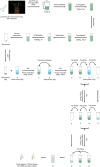Comparative Proteomic Analysis of Plasma Membrane Proteins in Rice Leaves Reveals a Vesicle Trafficking Network in Plant Immunity That Is Provoked by Blast Fungi
- PMID: 35548300
- PMCID: PMC9083198
- DOI: 10.3389/fpls.2022.853195
Comparative Proteomic Analysis of Plasma Membrane Proteins in Rice Leaves Reveals a Vesicle Trafficking Network in Plant Immunity That Is Provoked by Blast Fungi
Abstract
Rice blast, caused by Magnaporthe oryzae, is one of the most devastating diseases in rice and can affect rice production worldwide. Rice plasma membrane (PM) proteins are crucial for rapidly and precisely establishing a defense response in plant immunity when rice and blast fungi interact. However, the plant-immunity-associated vesicle trafficking network mediated by PM proteins is poorly understood. In this study, to explore changes in PM proteins during M. oryzae infection, the PM proteome was analyzed via iTRAQ in the resistant rice landrace Heikezijing. A total of 831 differentially expressed proteins (DEPs) were identified, including 434 upregulated and 397 downregulated DEPs. In functional analyses, DEPs associated with vesicle trafficking were significantly enriched, including the "transport" term in a Gene Ontology enrichment analysis, the endocytosis and phagosome pathways in a Encyclopedia of Genes and Genomes analysis, and vesicle-associated proteins identified via a protein-protein interaction network analysis. OsNPSN13, a novel plant-specific soluble N-ethylmaleimide-sensitive factor attachment protein receptor (SNARE) 13 protein, was identified as an upregulated DEP, and transgenic plants overexpressing this gene showed enhanced blast resistance, while transgenic knockdown plants were more susceptible than wild-type plants. The changes in abundance and putative functions of 20 DEPs revealed a possible vesicle trafficking network in the M. oryzae-rice interaction. A comparative proteomic analysis of plasma membrane proteins in rice leaves revealed a plant-immunity-associated vesicle trafficking network that is provoked by blast fungi; these results provide new insights into rice resistance responses against rice blast fungi.
Keywords: Oryza sativa L.; iTRAQ; plasma membrane; proteomics; rice blast; vesicle trafficking.
Copyright © 2022 Zhao, Li, Zhang, Yu, Ma, Wang, Fan, Huang, Wang, Liu, Dong, Tang, Wang, Zhang and Bao.
Conflict of interest statement
The authors declare that the research was conducted in the absence of any commercial or financial relationships that could be construed as a potential conflict of interest.
Figures








Similar articles
-
OsSYP121 Accumulates at Fungal Penetration Sites and Mediates Host Resistance to Rice Blast.Plant Physiol. 2019 Apr;179(4):1330-1342. doi: 10.1104/pp.18.01013. Epub 2019 Jan 7. Plant Physiol. 2019. PMID: 30617050 Free PMC article.
-
iTRAQ proteomics reveals the regulatory response to Magnaporthe oryzae in durable resistant vs. susceptible rice genotypes.PLoS One. 2020 Jan 10;15(1):e0227470. doi: 10.1371/journal.pone.0227470. eCollection 2020. PLoS One. 2020. PMID: 31923921 Free PMC article.
-
Proteomic analysis of the defense response to Magnaporthe oryzae in rice harboring the blast resistance gene Piz-t.Rice (N Y). 2018 Aug 15;11(1):47. doi: 10.1186/s12284-018-0240-3. Rice (N Y). 2018. PMID: 30112588 Free PMC article.
-
Recent progress in understanding PAMP- and effector-triggered immunity against the rice blast fungus Magnaporthe oryzae.Mol Plant. 2013 May;6(3):605-20. doi: 10.1093/mp/sst015. Epub 2013 Jan 22. Mol Plant. 2013. PMID: 23340743 Review.
-
Proteomics of Rice-Magnaporthe oryzae Interaction: What Have We Learned So Far?Front Plant Sci. 2019 Oct 29;10:1383. doi: 10.3389/fpls.2019.01383. eCollection 2019. Front Plant Sci. 2019. PMID: 31737011 Free PMC article. Review.
Cited by
-
Integrated proteomic analysis reveals interactions between phosphorylation and ubiquitination in rose response to Botrytis infection.Hortic Res. 2023 Nov 14;11(1):uhad238. doi: 10.1093/hr/uhad238. eCollection 2024 Jan. Hortic Res. 2023. PMID: 38222823 Free PMC article.
-
Vesicle trafficking in rice: too little is known.Front Plant Sci. 2023 Sep 18;14:1263966. doi: 10.3389/fpls.2023.1263966. eCollection 2023. Front Plant Sci. 2023. PMID: 37790794 Free PMC article. Review.
References
-
- Agarwal P., Reddy M. K., Sopory S. K., Agarwal P. K. (2009). Plant rabs: characterization, functional diversity, and role in stress tolerance. Plant Mol. Biol. Rep. 27 417–430. 10.1007/s11105-009-0100-9 - DOI
LinkOut - more resources
Full Text Sources
Molecular Biology Databases
Research Materials

